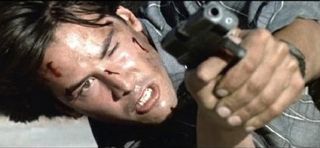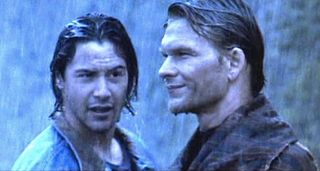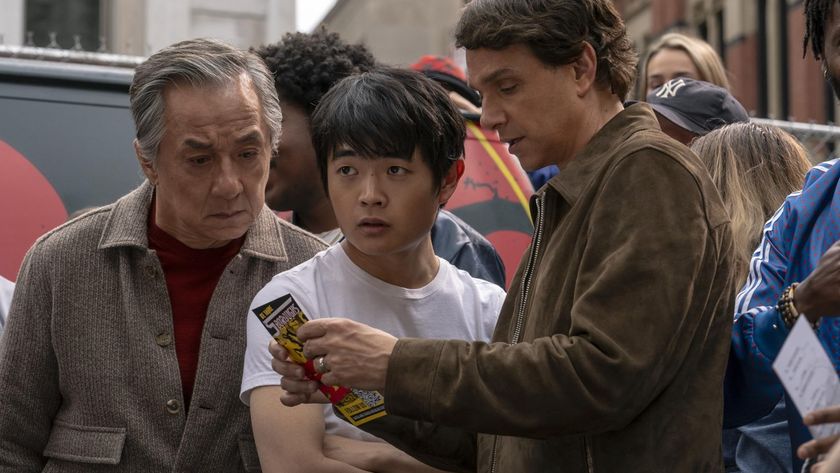The Story Behind Point Break
Why Bigelow's best is totally Swayze...

Husband vs Wife
It's summer 1991, and married directors James Cameron and Kathryn Bigelow have films coming out within weeks of each other.
His is Terminator 2: Judgment Day , the feverishly anticipated follow-up to his 1984 sci-fi classic. Hers is Point Break, a largely unheralded actioner starring a post- Ghost Patrick Swayze and Bill & Ted 's Keanu Reeves.
“It's interesting to see if we can stay married after the grosses come in,” Cameron joked in an interview.
But before the year is out, the couple are divorced. And while T2 is a global box-office smash, Point Break is derided by the critics and opens to only moderate business...

The Plot
Point Break , with its gleefully preposterous B-movie plotline and endlessly rewatchable set-pieces, was tailor-made for video. Here was a cult, not in the making but one fully formed – a brilliantly kinetic, breakneck-paced thriller that both adhered to and subverted genre norms.
On one level, it's a deeply conventional blockbuster with a gloriously dopey, high-concept pitch (FBI rookie infiltrates a team of surfing bank robberts).
On another, it's a feminist attack on jaded Hollywood clichés that objectifies the male form and skewers the latent homoeroticism in action cinema.
And on another, it's a robust political satire that pointedly has its bad guys commit crime disguised as former American presidents. (“We've been screwing you for years, so a few more seconds shouldn't matter now, should it?” says Swayze from behind a Ronald Reagan mask.)

Action!
The wonderful thing about Point Break is that whatever angle you approach it from, there's more to it than you think.
First and foremost it's a popcorn action movie. But Bigelow – a gifted painter and Columbia Film School graduate – is no ordinary action director.
Look at most examples of the genre, from James Bond onwards and it's all about the hardware: big guns, fast cars, high-tech gadgets.
For Bigelow, it's movement - physical action. The military precision of an organised bank job; the divine prowess of a sun-kissed wave-chaser; the breathless vigour of a foot pursuit shown in real time from the pursuer's shaky, blurred viewpoint.
Even one seemingly straightforward sequence – Keanu's first day at his new office – becomes a thing of beauty, as Bigelow's restless Steadicam tracks him through doors, corners and desks in one fluid and unbroken shot.

Bodhi & Johnny
Of course, the real things of beauty are Reeves and Swayze themselves.
In most Hollywood product, it's the girls who appear topless; here it's the blokes, their tanned torsos and honed pectorals framed in a series of leering, lingering close-ups. (Reeves' introduction – shooting at cardboard targets in the middle of a downpour – is effectively a wet T-shirt competition.)
The only female exposure comes from a naked harpy whose nudity doesn't stop her kicking the shit out of an FBI agent. And though Reeves has a nominal love interest in Lori Petty (who tellingly absents herself from one dick-measuring contest with the words, “Too much testosterone here!”), the true romance is between the reckless, risk-taking newbie Johnny Utah and Swayze's Zen master criminal Bodhi. (“You're getting too goddamn close to this surfer guru buddy of yours!” gripes Gary Busey's FBI old-timer with visible distaste.)
Just count the times the stars grapple each other: in the sea, on the ground, even in the air. “I know it's hard for you, Johnny,” says Bodhi, shortly before jumping out of an airplane (a stunt that Swayze daringly performed himself). “You want me so bad it's like acid in your mouth...”
“Are we going to jump or jerk off?” quips Reeves in another loaded exchange that gives a whole new meaning to Bodhi's search for “the ultimate ride”...

Keanu Comes Good
The movie plays perfectly well without such readings – but the gay subtext is undeniable. So much so that you begin to see it even when it's probably unintentional, as in the opening titles that show Reeves and Swayze's credits slide, merge and, yes, come together.
Keanu's action-man image may have been built on Speed and cemented by The Matrix , but Point Break was where the groundwork was laid. (According to executive producer Cameron, Bigelow “went to the mat for Keanu. She insisted he could be an action star. She worked on his wardrobe, showed him how to walk, made him work out. She was his Olympic coach.”)
And he's certainly effective, holding his own in the fisticuffs and showing no qualms about putting himself in harm's way (notably during a frenetic house raid that sees his pretty-boy features come perilously close to a lawnmower's whirring blades).
OK, so thereês rather too much Ted in his vacant posturing and slack-jawed inarticulacy (“I can't express how I'm feeling!”). But at least he has the sense to acknowledge his surfer-dude baggage, even spoofing it during one comical encounter with a hairy beach-bum. (“Saved your life, bro. Close one!”)

Career Bests
And so to Swayze... His blond-barneted, conflicted-villain spiritualist is more inadvertently amusing than dangerously inspirational. But he deserves credit for subverting his good-guy persona so soon after Ghost – even if, Donnie Darko apart, it sadly didn't lead to better things.
Before this year's triumphant return with kinetic Iraq war docu-thriller The Hurt Locker , the same could have been said of Bigelow. Her subsequent offerings - Strange Days , the little-seen The Weight Of Water and K-19: The Widowmaker – seemed flat and uninspired compared to the terrific trilogy of Near Dark , Blue Steel and this, her undisputed classic.
Perhaps aware she might become pigeonholed as an action director or, worse, Cameron's protege, Bigelow still seems reluctant to make another all-out action picture.
But if she'd never set foot behind a camera again, her reputation is assured thanks to this heart-pumping, adrenaline-inducing, totally bodacious butt-booter. Surf's up, dude...
Neil Smith is a freelance film critic who has written for several publications, including Total Film. His bylines can be found at the BBC, Film 4 Independent, Uncut Magazine, SFX, Heat Magazine, Popcorn, and more.













